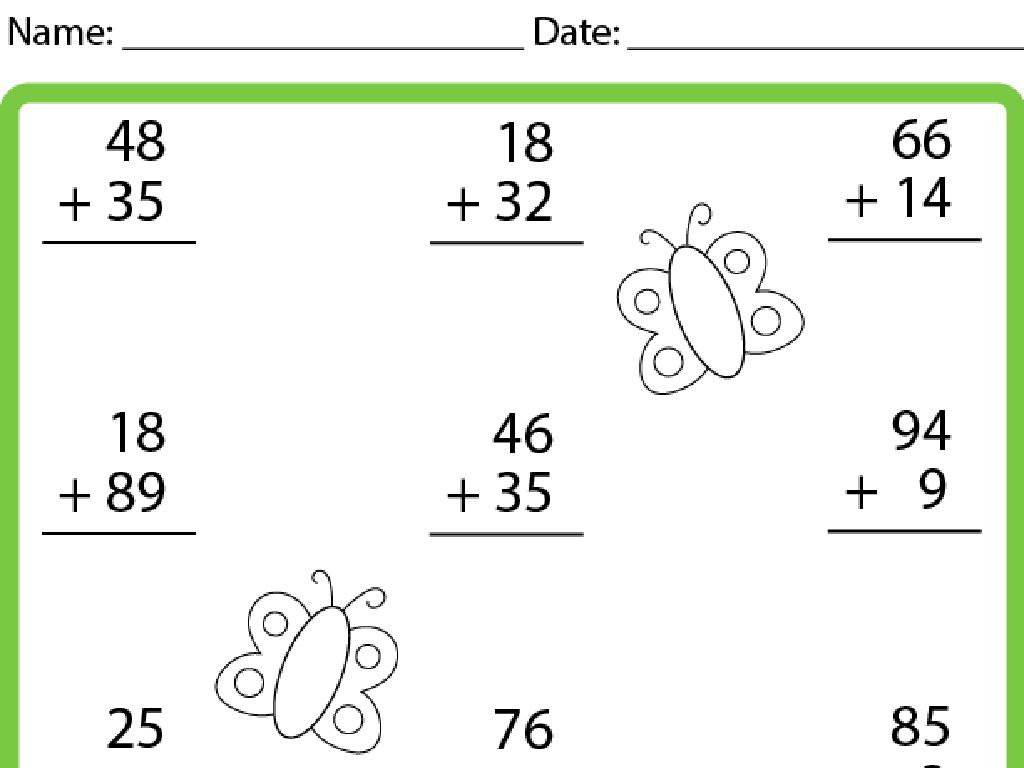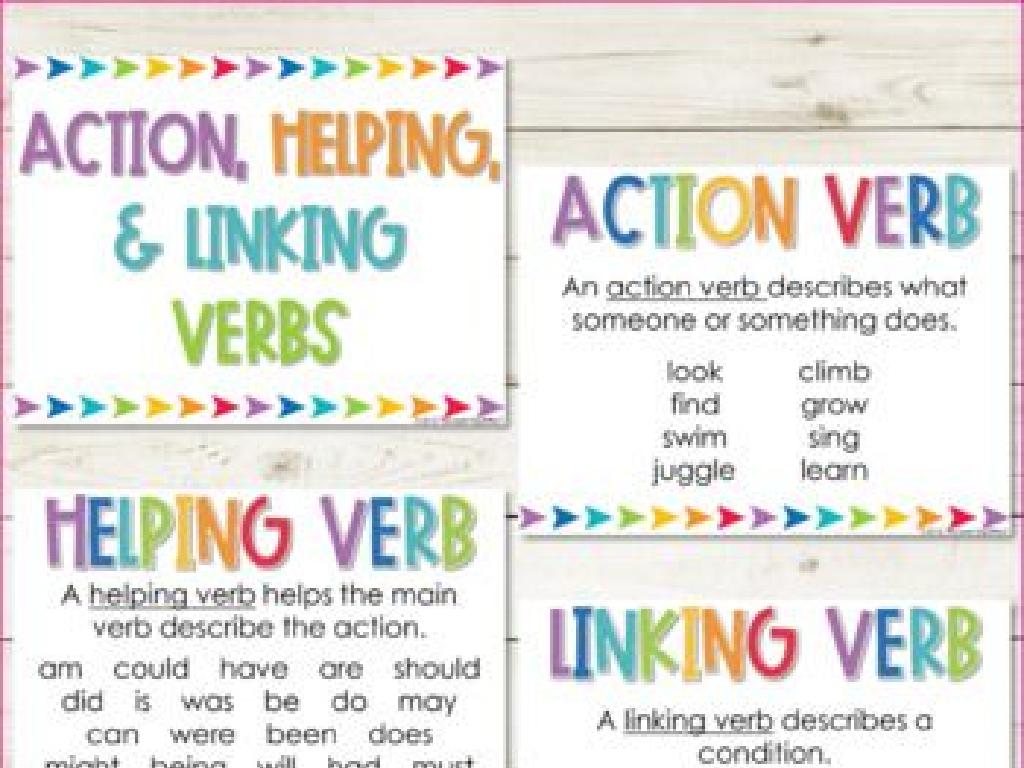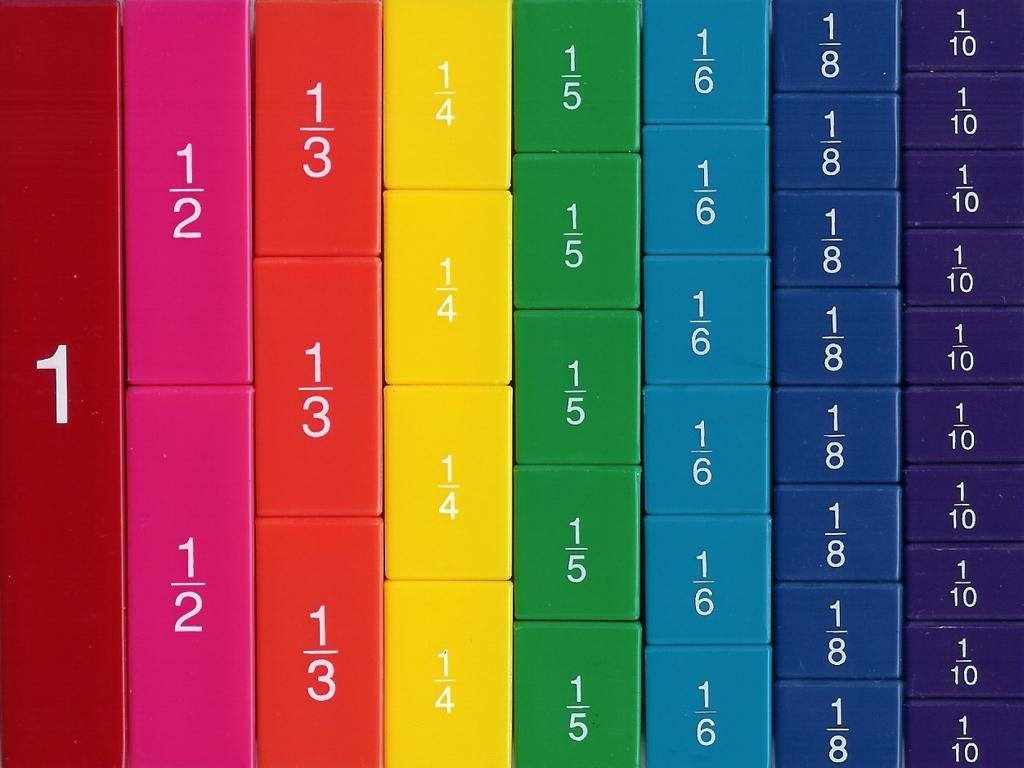Find The Long E Word
Subject: Language arts
Grade: Kindergarten
Topic: Long Vowels
Please LOG IN to download the presentation. Access is available to registered users only.
View More Content
Exploring the Long ‘E’ Sound
– Learn about the long ‘e’ sound
– Practice saying ‘eeee’
– Like ‘eeee’ in ‘tree’
– Become word detectives
– Search for words with ‘eeee’
– Find long ‘e’ words
– Examples: ‘be’, ‘me’, ‘see’, ‘bee’
|
This slide introduces the concept of long vowel sounds to Kindergarten students, focusing on the long ‘e’. Start by explaining what long vowels are and how they differ from short vowels. Have the children practice making the long ‘e’ sound by imitating common words such as ‘tree’. Encourage them to listen for this sound in words and to identify as many words with the long ‘e’ as they can. Use visual aids like pictures of words that contain the long ‘e’ sound. Plan a fun activity where students can act as ‘word detectives’ looking for long ‘e’ words around the classroom or in books they enjoy. This will help reinforce their understanding and recognition of the long ‘e’ sound in a playful and engaging way.
Exploring the Long ‘e’ Sound
– What is a Long ‘e’ sound?
– It sounds like ‘eeee’ as in ‘see’.
– Long ‘e’ vs. Short ‘e’
– Short ‘e’ sounds like ‘eh’ in ‘bed’.
– Listening to Long ‘e’ examples
– We’ll hear words like ‘bee’, ‘tree’, and ‘knee’.
– Practice finding Long ‘e’ words
|
Introduce the concept of the long ‘e’ sound by comparing it to the name of the letter ‘E’. Highlight the difference between long ‘e’ and short ‘e’ sounds with clear examples. Use common words that the students may already be familiar with to illustrate the long ‘e’ sound. Engage the class by listening to examples together, which can be done through a song or by saying words aloud. Encourage the students to practice finding and recognizing words with the long ‘e’ sound both in the classroom and at home. This will help them differentiate between long and short vowel sounds in words, a key skill in early reading development.
Finding the Long ‘e’ Sound
– Words with long ‘e’: bee, tree, seed
– Like in ‘bee’, where ‘e’ sounds like ‘ee’
– The ‘e’ stretches the sound
– It’s not a short ‘e’ as in ‘bed’
– Practice saying them aloud
– We’ll say them as a class to learn
– Listen for the long ‘e’ in words
|
This slide introduces the concept of the long ‘e’ sound to Kindergarten students. Start by presenting the examples of long ‘e’ words and emphasize the stretched-out ‘ee’ sound. Encourage the students to notice the difference between the long ‘e’ and short ‘e’ sounds by comparing words like ‘bee’ and ‘bed’. Engage the class by saying the words together and listening for the long ‘e’ sound in each word. This auditory exercise helps students recognize and pronounce the long ‘e’ sound, which is an important phonetic skill in early reading development.
Let’s Find the Long ‘e’ Sound!
– Play a game to find long ‘e’ words
– Look at pictures and say words out loud
– For example, ‘tree’, ‘bee’, ‘knee’
– Listen for the long ‘e’ sound in words
– The long ‘e’ sounds like the letter ‘E’
– Thumbs up for words with long ‘e’
|
This slide is for a fun and interactive game to help Kindergarten students recognize the long ‘e’ sound in words. Display pictures that represent words with the long ‘e’ sound, such as ‘bee’, ‘tree’, or ‘knee’, and have the students say the words aloud. Encourage them to listen carefully to the sounds in each word and use a thumbs-up gesture if they hear the long ‘e’ sound. This activity will help students associate the visual representation of words with their phonetic sounds, reinforcing their phonics skills. Make sure to praise their efforts and correct gently if they make mistakes, providing the right pronunciation and encouraging them to try again.
Practice Time: Writing Long ‘e’ Words
– Look at the picture shown
– Write the word with long ‘e’
– Words like ‘tree’, ‘see’, or ‘bee’
– Listen for the ‘ee’ or ‘ea’ sound
– The long ‘e’ sounds like ‘ee’ as in ‘bee’ or ‘ea’ as in ‘leaf’
– Share your word with the class
|
This slide is for a class activity where students practice identifying and writing words with the long ‘e’ sound. Show a picture that represents a word with the long ‘e’ sound, such as ‘bee’, ‘tree’, or ‘sea’. Encourage the students to carefully listen for the long ‘e’ sound and then write the word they believe matches the picture. Provide assistance as needed and praise their efforts to build confidence. After writing, invite students to share their words with the class. This will help reinforce their understanding of the long ‘e’ sound and how it appears in different words.
Class Activity: Long ‘e’ Word Hunt
– Explore our classroom on a word hunt
– Find objects with the long ‘e’ sound
– Look for ‘ee’ or ‘ea’ in words like ‘bee’ or ‘leaf’
– Team up with a classmate
– Make a list of your discoveries
– Write down or draw the objects you find
|
This activity is designed to help students recognize the long ‘e’ sound in a fun and interactive way. By exploring the classroom, they will engage with their environment and apply their phonics knowledge in a practical setting. Encourage students to work in pairs to foster teamwork and communication. Provide examples of words with the long ‘e’ sound to get them started. As a teacher, prepare a list of possible objects they might find, such as ‘tree,’ ‘seed,’ ‘leaf,’ ‘sheep,’ and ‘key.’ After the hunt, regroup and discuss the findings, reinforcing the pronunciation and spelling of the long ‘e’ words they discovered.
Great Detectives of Long ‘e’ Sounds!
– Celebrate finding long ‘e’ words
– Understanding the long ‘e’ sound
– The long ‘e’ sounds like the letter ‘e’ itself.
– Listen for long ‘e’ words daily
– Hear it in ‘beet’, ‘meet’, or ‘sheep’ while you play or read.
– Practice makes perfect
– Keep practicing to become a long ‘e’ expert!
|
This slide is a conclusion to the lesson on long ‘e’ words. It’s meant to celebrate the students’ success in identifying words with the long ‘e’ sound and to encourage them to continue practicing this skill in their everyday lives. Remind them to listen for the long ‘e’ sound in conversations, during story time, or while watching their favorite shows. Reinforce the concept by reading a book together as a class and pointing out the long ‘e’ words, or by having a ‘long e’ word of the day in the following days.






